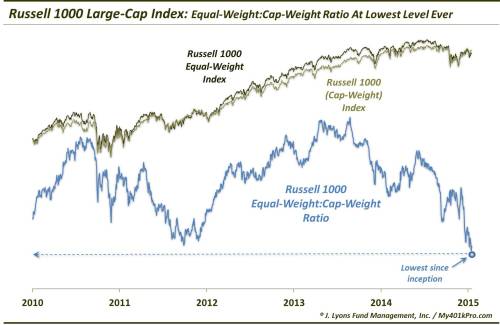Courtesy of Dana Lyons
The bull market in U.S. equities has narrowed over the past 6 months as strength has become concentrated in large cap stocks. Recently, strength has narrowed even among those large caps.
One common theme in these pages (and others) over the past 6 months has been the narrowing of participation in the equity bull market. That is, the rally has persisted among the major averages, but fewer and fewer stocks are rallying alongside. This dynamic is possible, of course, due to the uneven weighting of most stock indexes. The largest stocks, either by market cap or by price, have the greatest impact on the performance of the indexes. And those big-cap stocks have shown little propensity thus far to slow down. However, just recently, we are seeing the narrowing of the rally even among these large cap stocks.
We touched on this trend earlier this month, pointing out that the “Equal-Weight” version of the Russell 1000 Large-Cap Index had been lagging behind the “market cap-weighted” version since this past May. That is evidence that even the average large-cap stock has failed to keep up with biggest of those stocks. Further, we illustrated in a chart that while the Russell 1000 cap-weighted Index was back near its May levels, the Equal-Weight Index, i.e., the average stock, had not only lagged, but was down some 6% over that time.
Today’s Chart Of The Day takes that contrast even further by looking at the relative ratio between the Russell 1000 Equal-Weight Index and the cap-weighted version. As of Friday, that ratio had dropped to its lowest level since the inception of the Russell 1000 Equal-Weight Index.

Granted, the Equal-Weight Index has only been around for 5 years. It would have been interesting to note its relative behavior around the top in 2007, and especially during the “great divergence” between 1998 and 2000. Nevertheless, we must read the recent developments in a negative light as the fewer number of stocks that are rallying, the less robust and resilient the rally is likely to be. Sure, it may have little to no impact on those areas that are still working right now. However, when those areas do begin to succumb to selling pressure, there will be precious little left to support the broader market.
There is no telling when the ultimate top in the major stock averages will be. However, participation in the rally is getting narrower and narrower – even among the bull market’s former leaders.
* * *



